
Home About Us Contact Us Subscribe

Home About Us Contact Us Subscribe
|
|
|
|
From Caterpillar to Butterfly: DuPage Children's Museum by Peter J. Exley Architect/architectureisfun and Nagle Hartray Danker Kagan McKay Architects Planners
Naperville, Illinois: The metamorphosis of a retail lumber building into a place that combines learning and fun offered the same experience to the design team. by Sharon Exley, MAAE, and Kristin Baker September 23, 2002 The first thing you see is a
35-foot-tall red door. “It’s an emblem of what we stand for,” explains Susan
Broad, the museum’s executive director, “because we are opening doors for
children.” Since the DuPage
Children’s Museum (DCM) was founded in 1987, it has been opening doors to
family learning. It had a nomadic existence as it first moved from town to town
and later to two temporary locations. The new 44,000-square-foot home for the
non-profit institution is the former Moser Lumber building near downtown
Naperville, Illinois. Attracting large numbers of families, the institution
itself has grown, both in size and in mission, and is well respected for its
original, innovative exhibit and outreach programs. “We encourage recycling and
reuse with children, and liked the idea of recycling and reusing an existing
facility,” says Broad. Transforming a commercial
lumber company into a thoughtful and efficient children’s museum was not an
easy task, but the collaboration between Peter J. Exley
Architect/architectureisfun and Nagle Hartray Danker Kagan McKay Architects
Planners Ltd. (NHDKM) combined the necessary talent and expertise required. “We
wanted to create an identity to change the building from a retail lumber
building to a building that plays an important civic role, owned by children
and the people in their lives,” says design architect Peter Exley, AIA. The partnership evolved
quite naturally. Exley had done some previous consulting work for DCM, so when
the museum purchased the building, they naturally considered him as a
candidate. NHDKM, an older and larger firm, had developed an expertise with
similar projects. Exley and Howard Kagan, AIA, an NHDKM principal, have known
each other for many years, both personally and professionally, and have
developed a mutual respect that seemed headed toward doing something together.
DCM was that “something.” The success of this
collaboration is due in part to comfortable egos that allowed each firm to
think for the good of the museum rather than their own design ambitions.
Furthermore, the personalities of the Exley/NHDKM design team really clicked
with the personalities of the museum’s design staff, making the project a great
deal of fun. After all, that’s a lot of what a children’s museum is about. Working closely with both
the museum staff and the City of Naperville, the design team developed a
comprehensive master plan, which includes future growth, connections to mass
transit, and complete accessibility for the disabled. Budgetary constraints, as
well as administrative “growing pains,” dictated that the project be phased in
order to achieve the museum’s long range goals. The recently completed Phase
One renovation and build-out represents the culmination of five years of site
acquisition, design, and building modifications necessary to convert the
existing structure into an inviting and safe environment. The first phase was not
easy. The long span structure required extensive reinforcing in order to meet
the requirements for assembly occupancy. Similarly, existing stairs had to be
rebuilt and an additional stair tower had to be added to meet the life and
safety codes. Just as important as these
pragmatic issues, great care and thought have also gone into the imagery and
playfulness of the project. Recycled into something extraordinary, the building
uses iconographic and symbolic elements children understand and appreciate. The
Big Red Door, for example, welcomes all visitors and has become the museum’s new
graphic identity. Face-to-face interviews with
children and the important adults in their lives provided the impetus for the
initial design. Children drew the new museum as they envisioned it. Their
drawings helped in a remarkable way to clarify the master-planning framework as
well as to identify some design details that appeared often in the drawings,
highlighting just how important they were to the children. The design team also
met with staff and outside arts, education, and science advisors – meetings
which Exley calls “absolute consultation.” Design alternatives resulted for
each floor, followed by in-depth communication about the museum’s future
programmatic, operational, aesthetic, and design needs for young visitors. From kids’ drawings to
delightful design, Phase One takes advantage of existing features such as high
ceilings and concrete framing. The architectural and exhibit design overlap to
add a lively sense of colors, dramatic
variations in scale with places to see things from different perspectives, and
personalizing the dynamic structure. New interior columns even reach like
children’s outstretched arms propping up the building – the whimsical result of
added bracing to the structural system. For an institution that
kindles curiosity and creativity, it is critical that the architecture also
provide stimulation and excitement. In a large building with a very limited
budget, obvious ways to create flow and excitement are through materials,
forms, and textures – the spaces and surfaces surprise and motivate. The design
is child-like, yet sophisticated, and includes 20 different colors of paint,
colored lights suspended in playful patterns, and a tactile wall that engages
even the youngest children as they walk through the corridor. Creating a colorful, joyful
environment shouldn’t impact the budget any more than a drab one. For the
design team, it was important to approach the architecture and design with a
cognizance for the people who will be using it. Because children are tough
end-users, materials were chosen as much for their durability as for their
color range. The new museum, arranged in “learning neighborhoods,” utilizes the
dynamic palette and uncommon design details to clearly identify and distinguish
the separate exhibit areas. Eye-popping colors, from a pulsating lime to a
“goober grape,” give definition and form to the engineering labs as well as the
art, math, and science experiences. Children find their way easily from one
zone to the next, and there are sweeping views allowing parents to keep a
watchful eye. At the entry, the striped
linoleum points in the direction of activity and fun. Any red door in the
building is a welcoming one, an invitation to explore and to experience
something new. A blue door, however, might have something secret hidden behind
it, such as a storage closet or staff space. Even donor panels brought about an
innovative, inexpensive detail. Made of brightly colored etched ceramic tile,
these panels add color and shine to the hallway they line. The Exhibit Story
The museum is very
interested in self-directed play. Many of the much-loved exhibits from the
former location have been re-incarnated and some new favorites added. The
exhibit zones, such as the Moser Construction House, AirWorks, WaterWorks,
Bubbles, and Engineering Kids, clearly respect what children are doing and
learning. Children are provided the
space to build their own experiences – with safety in mind. Exley feels that
the Construction House, for example, not only gives children the freedom to use
real equipment (like nails, saws, hammers, and safety goggles), but also
provides a safe environment and encourages safety skills. Lisa Notter,
marketing manager for the museum, says: “We use nails – most museums think
we’re crazy for using real nails.” In reality, the culture facilitated by the
design and the educators who staff it instills a sense of responsibility and
privilege – kids are thrilled to be given the opportunity to use real
“grown-up” tools, and respect and attentively follow the “rules” of behavior
necessary in the Construction House. The interior of the
Construction House was purposely left “under construction” to further the
child’s understanding and exploration of building materials. A loft-like space
allows children to finish off the roofing, climb up into the ductwork, and
offers a different vantage point. Large pipes also extend outside of the house
so children can imagine forts, tents, or mazes to run through. Bubbles is a perennial
favorite and typically a maintenance worry. Huge car wash brushes, like
enormous totems, delineate the zone – and keep the bubbles where they belong.
Children also love to wipe their hands on them and squeeze their bodies
in-between two brushes, some of which were planned deliberately too close to each
other. The concrete flooring and rubber mats are durable and easy to maintain. Children are blown away by
AirWorks. The 6-foot-diameter transparent wind tunnel allows air to become a
force in a child’s life. Outside the tunnel, everyone can watch the child
experiment by throwing a Frisbee or by flying streamers and kites. In Make It
Move, there’s a lot of pushing, dropping, rolling, and pulling going on.
Children use energy and coordination to focus on the laws of motion. The Exley
team designed inclined walls, climb-throughs, planes, and ramps to move bodies
and balls through and around. Sue
Broad says, “Having fun should be a given for a project as playful and
stimulating as a creating a new children’s museum. This renovation process
presented many challenges along the way that were addressed collaboratively,
creatively, and with quirky good humor. It is so easy for an architectural firm
to tell you that they work ‘collaboratively’…but with this team the
collaborative process was a reality.” Attendance
has more than doubled – the museum is now welcoming more than 300,000 visitors.
The building and integrated exhibits are a major factor in this increase. Phase
Two will soon add another 20,000 square feet with a new entry and larger red
door, additional exhibit space, an outdoor rooftop exhibit garden, and parking
facilities. Client:
DuPage Children’s Museum; Susan Broad, Executive Director, Cynthia Mark-Hummel,
Project Director Design
Architect: Peter J. Exley Architect Design
Team: Peter Exley, AIA, Sharon Exley, MAAE (Educative Designer), Adrian
Ferguson (Architect) Architect
of Record: Nagle Hartray Danker Kagan McKay Architects Planners Design
Team: Howard Kagan, AIA (Principal), John Gleichman, AIA Note: The
above firms collaborated on the building’s exterior and interior architecture
and design. Exhibit
Design: Peter J. Exley Architect – architectureisfun Retail
Store design: Charles Sparks Construction
Engineer: GASAI Engineering, Don Jabcyznski Construction
Services: Graycor, Inc. Linoleum flooring:
Forbo Recycled plastic panels: Yemm & Hart Make-it-Move fabricator: Superior Exhibits & Design
Inc., Elk Grove Village, IL Photography:
Doug Snower Photography - 312-943-1500 Peter Exley, AIA, and Sharon Exley are teachers, educative
designers, and generators of good ideas; together they have amassed an
impressive portfolio of interactive architecture and environments for children.
Founded in 1994, their
award-winning firm, architectureisfun, develops architecture, interiors, exhibits, and learning
resources for clients interested in sensorial and enlightened experiences as
part of daily life. Nagle Hartray Danker Kagan McKay (NHDKM
) provides a broad range of services related to architecture, interior design,
and planning. Founded in 1966, the firm's award-winning design has included new
and revitalized structures of virtually every building type. NHDKM's staff of
32 includes 19 licensed architects holding registrations in 12 states.
Commercial, cultural, educational, and residential projects include Harpo
Studios (Oprah Winfrey Show); the University of Chicago; Art Institute of
Chicago; Spurlock Museum of World Cultures; multi-family and senior housing. Authors: Sharon
Exley, MAAE, Partner, architectureisfun - Peter J. Exley Architect, consults on
a regular basis to institutions such as the Art Institute of Chicago and
Chicago's Museum of Contemporary Art; presenting family and teacher workshops.
She is co-author of “The Best of Everything for Your Baby (Prentice-Hall), and
writes frequently for design publications. Kristin Baker, is Business Development Director at
Chicago-based Nagle Hartray Danker Kagan McKay |
(click on pictures to enlarge) 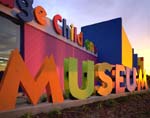 (Doug Snower Photography) The DuPage Children's Museum raucously colored exterior signage signals there's fun to be had inside.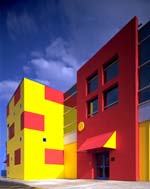 (Doug Snower Photography) The 35-foot-tall Big Red Door welcomes visitors and has become the museum's new graphic identity.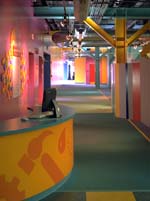 (Doug Snower Photography) The museum's structural columns create a fanciful forest of form and rhythm.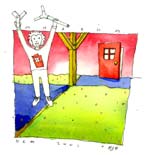 (Peter J. Exley, AIA) Exley's charming column design resembles children's arms reaching out and holding up the building.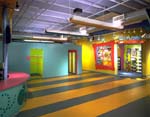 (Doug Snower Photography) The colorful entry includes a retail store designed by Charles Sparks.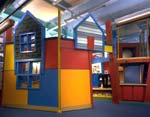 (Doug Snower Photography) The Moser Construction House provides real building materials and tools for constructive problem solving.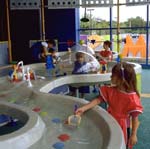 (Doug Snower Photography) The "Sink and Float" water table provides a gentle sensorial experience for children and their caregivers.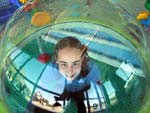 (Peter J. Exley, AIA) Emma pops up underneath the water table but manages to stay dry.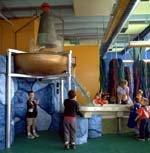 (Doug Snower Photography) Children learn that water is a force in the "fantastic" Fast Flow table.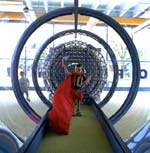 (Doug Snower Photography) Kids can watch other kids being wind-blown in the transparent AirWorks tunnel.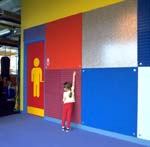 (Doug Snower Photography) TacTile Walls around the museum use various types of recycled, magnetic, and acoustic materials.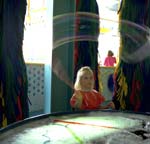 (Doug Snower Photography) A circle of car wash brushes keep Bubbles where they belong.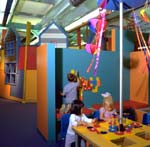 (Doug Snower Photography) Children "Make It Move" by playing with ramps and rollers using "KIDnetic" energy.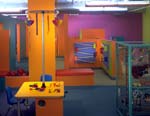 (Doug Snower Photography) Make it Move: eye-popping colors, from a pulsating lime to a "goober grape," are used throughout the museum.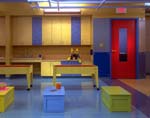 (Doug Snower Photography) The Learning Lab is a powerful design and learning experience, incorporating multiple perspectives of designer, client, programmers, educators, and children.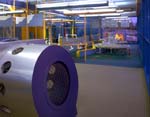 (Doug Snower Photography) Overall view from the wind tunnel to the Sink and Float water table.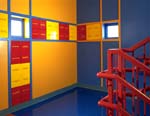 (Doug Snower Photography) The Donor Wall uses ordinary bathroom tiles etched with donor names and messages.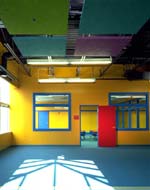 (Doug Snower Photography) A gathering spot perfect for events and rental, the multi-purpose room also works for changing exhibits and gallery showings. (-) Floor plan |
© 2002 ArchNewsNow.com